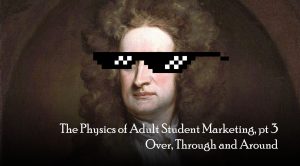by Jeff Ebbing
Southeastern Community College
West Burlington, IA
 [Author’s Note: Comes now the thrilling conclusion of the epic Marketing Guy trilogy, The Physics of Adult Student Marketing. It would do you well to check in on the first part and the second part before entering the thunderdome that is part three wherein I tie all the disparate storylines together in a stroke of genius.]
[Author’s Note: Comes now the thrilling conclusion of the epic Marketing Guy trilogy, The Physics of Adult Student Marketing. It would do you well to check in on the first part and the second part before entering the thunderdome that is part three wherein I tie all the disparate storylines together in a stroke of genius.]
Haven’t read parts one and two yet? Suit yourself. Be advised that fools rush in where angels fear to tread. But since I’m a nice guy, I’ll humor you with a brief refresher that in no way equates to experiencing the other two posts in all their Newtonian glory.
Sir Isaac uses his first law of inertia to explain the challenge of getting adults to simply consider going to college. They have to see themselves as a college student before they ever choose to be one. Your singular goal is to get the mental ball rolling.
He employs his second law to change their trajectory. They’ve been busy being not in school for decades. Your paths will never cross until you leverage all the forces at your disposal to get them to your door.
 Now we come to the Warden of Mint’s (my fave Warden of Mint, truth be told) third law: for every action, there is an equal and opposite reaction.
Now we come to the Warden of Mint’s (my fave Warden of Mint, truth be told) third law: for every action, there is an equal and opposite reaction.
Basically, it’s up to you to keep them here and help them over the finish line.
While not easy, we’re often able to push through the inertia and get them here but most adults have one last force to overcome: life. Family, job, money – they burn all their energy dealing with everyday challenges, they sometimes just don’t have any more gas to overcome yet another obstacle.
Pop quiz: remember my amazing leaky tire analogy from part one? Pshhh. Hold my C2H6O.
By and large, adults are some of the most motivated students you’ll ever meet. They sacrificed a lot to get here. They take their education seriously. However, don’t count your diplomas before they’re earned. For all their efforts, these students’ success is as precarious as driving behind a flatbed truck full of nails. And it’s a bumpy road. And they’ve got four bald tires. And each nail was dipped in rubber-eating acid.
Every one of those tiny, seemingly innocuous nails are little life challenges with the ability to send even the most promising student careening into the ditch: a sick child, a past-due electric bill, and yes, even a flat tire.
This happens at your school way more often than you realize: child gets sick, student has to stay home, student misses important test, student can’t make up test because of work schedule, student struggles to recover lost points, student gets overwhelmed and drops class, student loses financial aid eligibility. Next semester they vanish. Game over.
That rascal Newton definitely saved the toughest for last. It’s not enough for you to match these forces, you have to overpower them. Thankfully, your college is uniquely equipped to help your students win this tug-of-war.
Help your students over, through and around obstacles to get (and keep) them in the classroom:
- Keep sharing stories. Whether recruitment or retention, people identify with others like themselves. Find students and alumni who persevered through struggles and setbacks. One well-told story can move a mountain.
- Plug them into the college community so they can develop a support network. Most career programs have a corresponding student club. Encourage them to join. Get the achievers into in PTK or student government. Nudge them to compete in academic and skills competitions or service projects. Engaged students are resilient students.
- Promote your support programs and services. Classes and academic programs are important, but equally important are the support systems that help students manage the challenges they have outside the classroom that free them to be successful inside the classroom. Are you talking up the benefits of your Trio program or your student advocates? How about tasking your tutoring center staff to make the rounds visiting classrooms before midterms? This kind of support can make or break a student’s success, so it’s vital they not only know it’s available but are comfortable enough to ask for it when they need it.
- Find them money. Part-time students are usually locked out of traditional financial aid vehicles. Develop part-time student scholarships. Offer a free credit class to adult ed grads. Create an emergency retention fund to help students pay an unforeseen bill. Buy down equipment startup expenses and cover licensure testing fees. Keep a list of scholarship resources handy and show them how to submit a killer application. Get your financial aid peeps to funnel good candidates to schedule-friendly work-study positions. Every minute they don’t have to spend thinking about money is one minute then can spend keeping the rest of their life on track.
There you have it. The physics of adult student marketing. It’s been hiding in plain sight for nearly four centuries, and now distilled for you in three convenient blog posts. Following all the steps laid out over this trilogy likely won’t win you the Nobel Prize, but if you apply the appropriate marketing force at these key moments, you will see movement in your adult student enrollment. Because, science.
In memory of my dear friend, NCMPR colleague and one of the sweetest human beings to ever grace the planet, Ann Rubenbauer. P.S. Cancer sucks.
Jeff Ebbing is the director of marketing and communications at Southeastern Community College in West Burlington, Iowa, and NCMPR’s District 5 director.


STAY CONNECTED